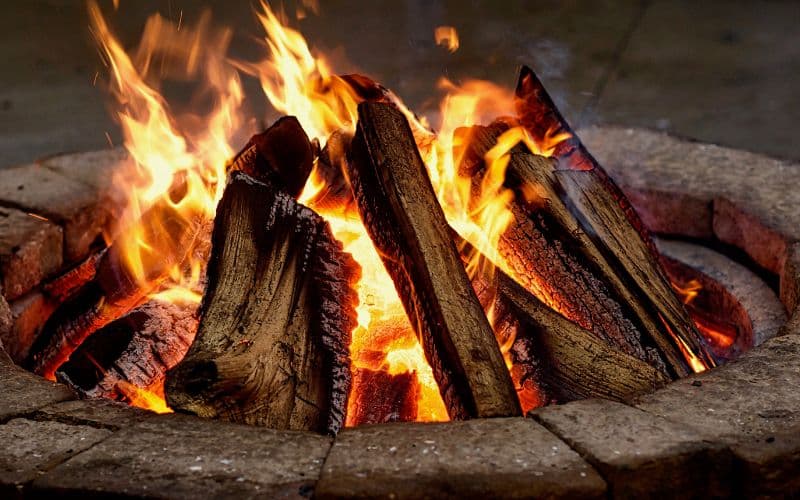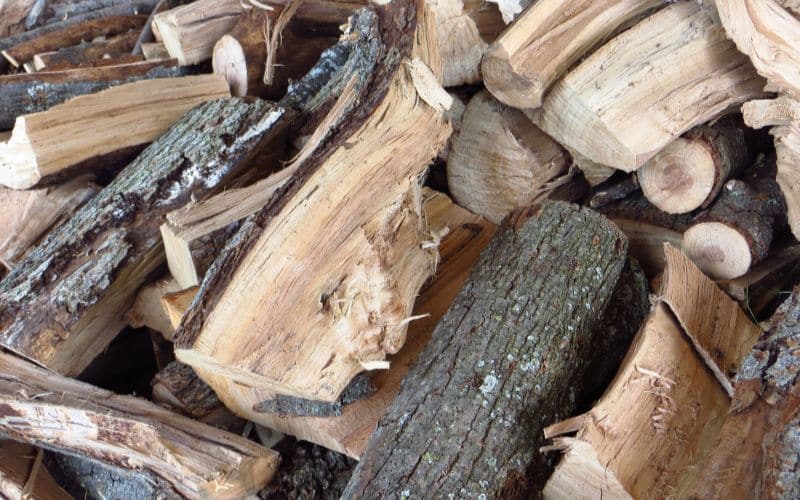
Selecting the right type of wood for your fire pit is more important than you might think. The quality, burn time, and heat output can all drastically affect your outdoor experience. Whether it’s a cosy evening with loved ones or a lively gathering with friends, the warmth and ambiance provided by a well-kept fire pit are truly unmatched.
Not all woods are created equal when it comes to providing an ideal fuel source for your fire pit. You’ll want something that lights quickly, burns hot without smoking excessively, and lasts for an appreciable amount of time. The choice of wood can also impact on how much ash is left behind – less ash means easier cleanup!
Remember: the goal isn’t just to have a fire. It’s about creating memorable moments in the warm glow of embers while ensuring safety and efficiency throughout. So let’s explore some excellent choices you could consider next time you’re stocking up for those relaxing nights around your beloved outdoor centrepiece.
Choosing the Right Wood for Your Firepit
When it comes to enjoying a crackling fire in your firepit, selecting the right wood is crucial. It’s not just about throwing any old logs into the pit; there are certain types of wood that burn better and cleaner than others.
Hardwoods such as oak, maple and birch are top choices for your firepit. They’re dense, which means they’ll burn longer and hotter compared to softwoods. You’ll appreciate this when you’re looking forward to a night spent around the warm glow of a well-fed fire.
Don’t overlook fruitwood either! Woods like apple or cherry can add an aromatic touch to your evening fireside experience. Their fragrant smoke makes them ideal for those relaxed backyard gatherings where mood matters as much as heat.
Avoid using treated woods or composite materials in your pit though. They often contain chemicals that can release toxic fumes when burned – definitely not what you want floating around at your family barbecue!
Remember:
- Hardwoods like oak, maple and birch burn long and hot
- Fruitwood such as apple or cherry adds an aromatic touch
- Avoid treated woods due to potential chemical emissions
It’s also worth noting that seasoned wood (that’s been dried out over time) will give you superior results compared with freshly cut ‘green’ timber which tends to smoke heavily without producing much heat.
So next time you’re loading up your firepit, take a moment to consider what kind of fuel you’re using – it could make all difference between an average blaze and one that truly lights up your evening.
The Best Types of Wood to Burn in a Firepit
When you’re readying your fire pit for those warm, cosy evenings outdoors, choosing the right type of wood is crucial. But don’t worry! We’ve got you covered with some top-notch recommendations.
You can’t go wrong with hardwoods like Oak and Ash. They’re known for their long burn times and excellent heat output. Not only that, they also tend to produce less smoke than other types – a big plus if you want to avoid getting smoke in your eyes!
- Oak: Known for its slow burning properties and high heat output.
- Ash: Celebrated as one of the best woods for burning due to its ability to burn even when green.
On the other hand, fruitwoods such as Apple or Cherry provide a unique twist. They not only create an inviting flame but also release delightful scents while they burn:
- Applewood: Creates a steady flame with moderate heat output.
- Cherrywood: Burns slowly with good heat production; it’s especially loved because it imparts a sweet-smoky scent.
If sustainability’s on your mind (as it should be), consider reclaimed lumber or recycled pallet wood – just make sure any coatings have been thoroughly removed before lighting up!
While we’re at it, let’s address what NOT TO BURN:
Avoid softwoods like Pine or Spruce which can spark dangerously due their resin content. Moreover these woods cause creosote buildup which may lead to chimney fires over time.

Factors to Consider When Selecting Wood for Your Firepit
When it comes to selecting the perfect wood for your fire pit, there’s a lot more than meets the eye. It’s not just about picking up any old logs and throwing them in; certain types of wood burn better and offer different benefits. Let’s delve into some key factors you should consider.
Firstly, think about what you want from your fire. Are you after a quick, hot flame or something that’ll smoulder for hours? Softwoods like pine ignite quickly and burn fast with high flames while hardwoods such as oak take longer to catch but give off more heat over time.
Next on the list is smoke production. If you’re planning on using your fire pit regularly, especially around guests or close to your home, then it’s wise to opt for woods that produce less smoke – maple or birch are solid choices here.
Your choice can also be influenced by how easily obtainable specific types of wood are in your area. Here’s a handy table breaking down common options:
| Type | Burn Speed | Smoke Level |
|---|---|---|
| Pine (Softwood) | Fast | High |
| Oak (Hardwood) | Slow | Moderate |
| Maple | Medium | Low |
Now let’s touch upon seasoning – this refers to how long the wood has been left dry out before burning it; seasoned logs have had at least six months whereas green logs haven’t dried yet which means they’ll create lots of smoke and potentially dangerous creosote buildup in chimneys if used indoors.
Last but definitely not least is safety! Always remember when handling any type of open flame: use gloves where possible & ensure children stay well clear whilst enjoying their toasted marshmallows!
How to Properly Store and Season Firepit Wood
Have you ever wondered why some firewood burns better than others? The secret lies in proper storage and seasoning. Let’s delve into this fascinating world of wood preparation.
Storing your firepit wood correctly is a crucial step towards ensuring it’ll burn effectively. Moisture is the enemy here – wet or damp wood doesn’t catch fire easily, leads to more smoke, and could potentially damage your fire pit over time.
So how can you store it properly?
- Keep your logs off the ground: A simple pallet or specially designed log rack can help prevent moisture from creeping up from the earth.
- Cover the top but not sides: Protecting your pile from rain is essential but avoid wrapping it entirely as this prevents airflow, trapping any existing moisture inside.
- Choose a sunny spot if possible: Sunlight will aid in drying out any residual dampness on the surface of the logs.
Now let’s talk about seasoning – which isn’t adding salt and pepper by way! It refers to drying fresh-cut timber until its moisture content falls below 20%. This process typically takes around six months but can vary depending on species of tree, local climate conditions, and size of cut pieces. Here are some tips:
- Stack freshly cut logs loosely for optimal airflow
- Avoid large piles; split them into smaller stacks instead
- Use a moisture meter (available at most hardware stores) regularly check progress
By taking these steps seriously, you’ll ensure that every flame dances with vigour when set alight in your cosy backyard oasis under twinkling stars. Remember that well-stored seasoned wood isn’t just about creating mesmerising flames; it also contributes significantly to reducing harmful emissions released during burning – so we’re doing our bit for Mother Earth too!

Conclusion: Maximising Your Fire Pit Experience with Quality Wood
When it comes to enjoying your fire pit, the quality of wood you use plays a crucial role. Not only does it influence the warmth and ambiance of your fireside gatherings, but also impacts longevity and safety of your fire pit.
It’s critical to choose hardwoods like oak, ash or hickory for their long-lasting heat. These woods have dense structures which enable them to burn hotter and longer than softwoods. Using hardwoods means you’ll spend less time replenishing the fire and more time basking in its glow.
If you’re concerned about sparks flying from crackling wood, go for seasoned wood that’s been dried out properly over 6-12 months. It’s less likely to pop or throw off dangerous embers compared to green or wet wood.
| Wood Type | Burn Time | Heat Output |
|---|---|---|
| Oak | Long | High |
| Ash | Medium | High |
| Hickory | Long | Very high |
Remember though, no matter what type of quality wood you opt for:
- Always store it in a dry place
- Never leave a burning fire unattended
- Extinguish flames thoroughly before leaving
It may take some experimenting before finding the perfect balance between heat output, burn duration and spark control that suits your needs best.
With these tips at hand, we’re confident that you can maximise enjoyment around your beloved fire pit while ensuring everyone stays safe – all thanks to choosing the right kind of quality wood! Now isn’t that a hot topic worth pondering upon? So here’s hoping this guide helps make those nights by the firepit even more memorable!








